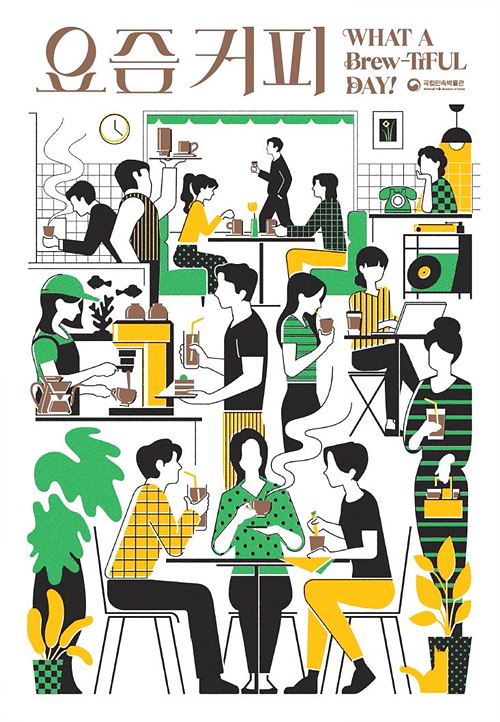Exhibitions
| Title | What a Brew-tiful day! | ||||||||||||||
|---|---|---|---|---|---|---|---|---|---|---|---|---|---|---|---|
| Period | 2024-08-20 - 2024-11-10 | ||||||||||||||
| Venue | Special Exhibition Hall 2 (NFMK Seoul) | ||||||||||||||
|

Exhibition OverviewI 'surely' have some coffee on the way to work. I 'definitely' enjoy coffee after lunch. I drink coffee 'together' when I meet with others. It seems like I 'constantly' have coffee.
You ask: “Do you like coffee?” I immediately say “Of course,” but after thinking about it, realize there are many things that taste better than coffee does. “So why drink it?” comes the next question. I can't think of a good answer. It's just what my body craves when the right time comes. According to surveys, Koreans say coffee ranks second among all the food and beverage items they like, with cabbage kimchi in first place and steamed rice coming in third. Rice, kimchi and coffee are always grouped together. Over the past century, coffee has become part of the traditional Korean diet. This exhibition introduces the coffee drinking habits of Koreans. Korea is well known as a place where coffee is consumed in large amounts. Why do the Korean people drink it so much? Perhaps you might think about having a cup of coffee after you leave this exhibition hall, filled with so many different coffee-related stories. A cup of coffee sweetens up the lives, yesterday, today and tomorrow. * Source: Korea Health Industry Development Institute, 2021, National Nutritional Statistics  Prologue. Coffee?There is a wide range of coffee choices in Korea. Grocery store shelves offer dozens of instant coffee mix, drip coffee, brewed coffee, and canned coffee products. Coffee drinks with unimaginable names fill the menus at coffee shops. Among the many choices, what should the Koreans select?
 Part 1. Daily Life × CoffeeKorean per capita coffee consumption is 405 cups a year, over twice the global average.* The prominent Korean politician Yu Gil-jun (1856–1914) saw how Westerners consumed coffee like water. He wrote: “They drink it the way Koreans drink sungnyung(a beverage made from crispy rice crust, known as 'nurungji' in Korean, commonly enjoyed after a meal).” How shocked he would be if he saw Koreans today. The scene of coee drinking naturally became part of Korean daily life some time ago. Of course, how Koreans drink it has changed. People don't preparing it themselves by boiling the water and brewing the coffee as much as they used to. Instead they are open seen holding a cup while on the go around town. The kinds of people who enjoy coffee and the places where coffee is consumed have evolved over time. However, Koreans were favorably accepted coffee from the start, and it naturally became part of their eating and drinking habits. Coffee drinkers were prominent in society in specfic time periods, set social trends, and encouraged romanticism. The coffee drinking venues were at the center of the “hot places to be.”The process of adopting coffee, a beverage that comes from foreign countries, in Korea is examined here by time period. * Source: Korea Agro-Fisheries & Food Trade Corporation, 2023 Food Industry Statistics ※ Materials: White porcelain cup and saucer set adorned with the plum blossom design, Powdered coffee is mixed with ground ginseng and sold as a product targeting Joseon tourists, The U.S. military combat rations and coffee that Koreans could try etc  Part 2. Coffee in MindToday, expression “Let's get some coffee” is more open heard as a greeting in Korea than “Let's get something to eat” is. Of course, it does not matter whether the beverage in question is instant coffee mix, iced Americano, specialty coffee, or capsule coffee. Coffee allows us to remember things in the past, dream about the future, and console us about the present. In addition, it weaves you, me, and all of us together. The human relations linked through coffee are exhibited through the stories of various people.
※ Materials: Photographs of dates and weddings, A television used in a Korean dabang, Coffee-flavored chewing gum, Mom's coffee cup etc  Epilogue. Yes, Coffee!Twenty grams of coffee beans are required to make a single cup of coffee. Koreans typically consume several cups of coffee each day, so how much would that total in our lives? Energy to start out the day, motivation to prepare for the future, a medium for recalling former times and people, a means for linking conversation with things going forward, an excuse for taking a break study, work or child rearing...
The meaning of coffee is neither decidedly light nor overly heavy. Perhaps that is why Koreans drink it. Today, too, nevertheless, It's conclude this exhibition by celebrating the day of coffee drinking.  Materials
|
|||||||||||||||
| Date | 2024-08-20 | ||||||||||||||


 Mobile Guide (3MB)
Mobile Guide (3MB)






